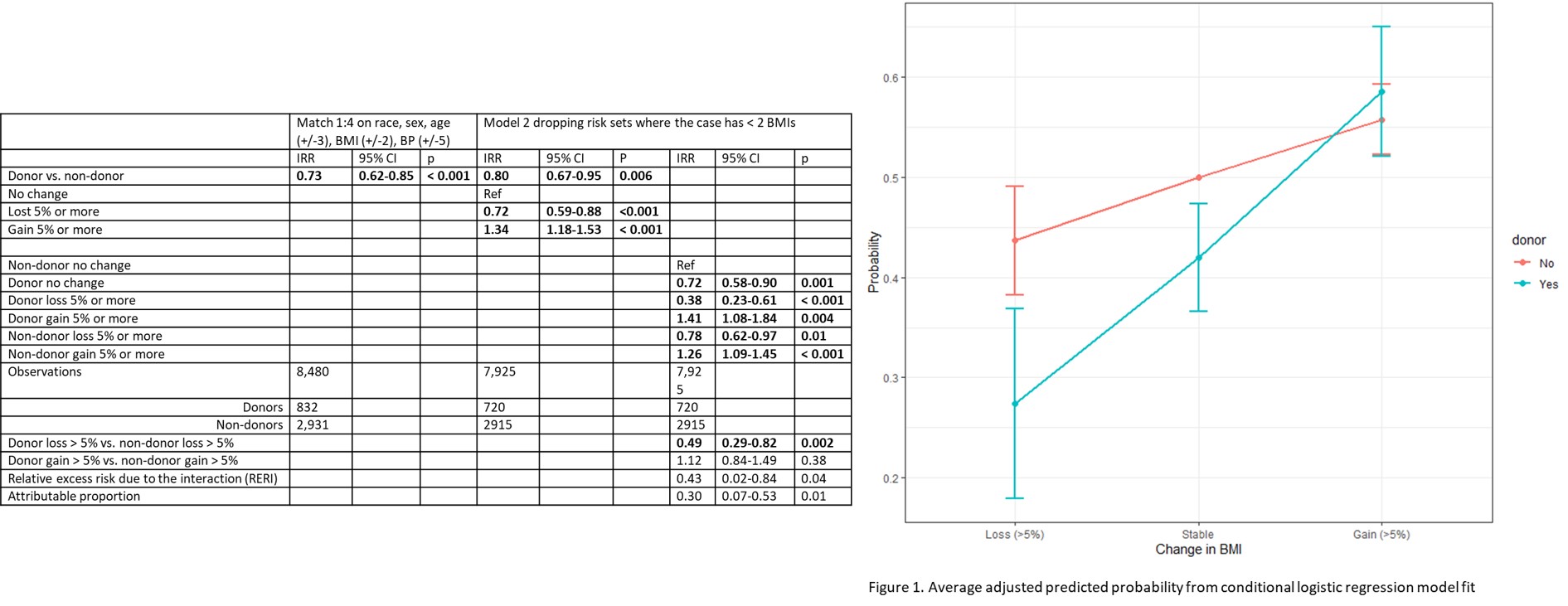BMI Trajectory and Attributable Risk of New Onset Hypertension Among Obese Living Kidney Donors
1Surgery, University of Alabama at Birmingham, Birmingham, AL, 2Nephrology and Hypertension, Mayo Clinic, Rochester, MN, 3Medicine, Hennepin County Medical Center, Minneapolis, MN, 4Surgery, University of California San Francisco, San Francisco, CA, 5Surgery, Johns Hopkins University, Baltimore, MD, 6Epidemiology, University of Alabama at Birmingham, Birmingham, AL
Meeting: 2022 American Transplant Congress
Abstract number: 100
Keywords: Multicenter studies, Outcome, Risk factors, Weight
Topic: Clinical Science » Kidney » 39 - Kidney Living Donor: Long Term Outcomes
Session Information
Session Name: Kidney Living Donor: Long Term Outcomes
Session Type: Rapid Fire Oral Abstract
Date: Sunday, June 5, 2022
Session Time: 5:30pm-7:00pm
 Presentation Time: 6:20pm-6:30pm
Presentation Time: 6:20pm-6:30pm
Location: Hynes Room 206
*Purpose: Obesity increases hypertension risk in general and living kidney donor populations. Risk attributable to donation in the context of obesity and whether that risk is modified by weight change are unknown. Our purpose was to examine whether changes in body mass index (BMI) modify the effect of kidney donation on incident hypertension.
*Methods: We performed a nested case control study in a retrospective cohort of 1,558 living donors with obesity from 58 US transplant centers and 3,783 adult participants with obesity in the Coronary Artery Risk Development in Young Adults (CARDIA) and Atherosclerosis Risk in Communities (ARIC) studies. Using conditional logistic regression, we examined hypertension incidence for donors vs. non-donors, with percent change in BMI explored as an effect modifier.
*Results: Overall, donors had lower incidence of hypertension than non-donors (incidence rate ratio (IRR): 0.73, 95%CI: 0.62-0.85, p<0.001), even after adjusting for BMI change (IRR: 0.80, 95%CI: 0.67-0.95, p=0.006). Donors with stable BMI or who lost >5% BMI had lower hypertension incidence vs. similar non-donors (stable BMI IRR: 0.72, 95%CI: 0.58-0.90, p=0.001; BMI loss IRR: 0.49, 95%CI: 0.29-0.82, p=0.002). However, >5% BMI gain significantly amplified hypertension incidence among donors (multiplicative interaction IRR: 1.55, 95%CI: 1.10-2.18, p=0.01; relative excess risk due to interaction: 0.43, 95%CI: 0.02-0.84, p=0.04), such that donors and non-donors who gained weight saw similar hypertension incidence (IRR: 1.12, 95%CI: 0.84-1.49, p=0.38).
*Conclusions: Obese living kidney donors were at lower risk for incident hypertension than obese non-donors. Importantly, weight loss was associated with a significant reduction in hypertension onset, with a more pronounced effect among donors. However, >5% weight gain in donors was associated with increased hypertension incidence and exceeded the expected effect of donation and weight gain combined, such that hypertension risk was similar to non-donors. These findings provide strong support for counseling obese potential living donors on weight management post-donation.
To cite this abstract in AMA style:
Reed RD, McLeod MC, MacLennan PA, Kumar V, Brooks SE, Maynor AG, Stanford LA, Baker GA, Schinstock CA, Silkensen JR, Roll GR, Segev DL, Orandi BJ, Lewis CE, Locke JE. BMI Trajectory and Attributable Risk of New Onset Hypertension Among Obese Living Kidney Donors [abstract]. Am J Transplant. 2022; 22 (suppl 3). https://atcmeetingabstracts.com/abstract/bmi-trajectory-and-attributable-risk-of-new-onset-hypertension-among-obese-living-kidney-donors/. Accessed January 4, 2026.« Back to 2022 American Transplant Congress

